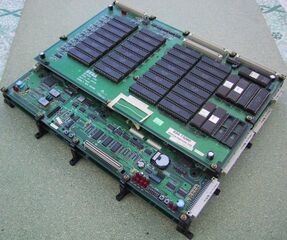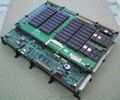Difference between revisions of "Sega Model 3"
From Sega Retro
| Line 46: | Line 46: | ||
* [[wikipedia:Arithmetic logic unit|ALU]]: [[wikipedia:Mitsubishi|Mitsubishi]] 3D-RAM | * [[wikipedia:Arithmetic logic unit|ALU]]: [[wikipedia:Mitsubishi|Mitsubishi]] 3D-RAM | ||
** [[wikipedia:Framebuffer|Framebuffer]] resolution: [[wikipedia:SXGA|1280×1024]] | ** [[wikipedia:Framebuffer|Framebuffer]] resolution: [[wikipedia:SXGA|1280×1024]] | ||
| − | ** Capabilities: Blending, depth check, stencil & raster operations, [[wikipedia:Pixel buffer|pixel buffer]], [[wikipedia:Tiled rendering|tiled rendering]], [[wikipedia:Z-buffering|Z-compare]], alpha blending, | + | ** Capabilities: Blending, depth check, stencil & raster operations, [[wikipedia:Pixel buffer|pixel buffer]], [[wikipedia:Tiled rendering|tiled rendering]], [[wikipedia:Z-buffering|Z-compare]], alpha blending, 400 million pixels/sec [[wikipedia:Rendering (computer graphics)|rendering]] [[wikipedia:Fillrate|fillrate]], 400 MB/s to 58.6 GB/s bandwidth, OpenGL support{{ref|http://pdf.datasheetcatalog.com/datasheets/2300/399112_DS.pdf}} |
* [[wikia:w:c:gaming:Display resolution|Display Resolution]]: 496×384 to [[wikipedia:480p|640x480]], [[wikipedia:Progressive scan|progressive scan]] (non-[[wikipedia:Interlaced video|interlaced]]), 24 kHz [[wikipedia:Horizontal scan rate|horizontal sync]], one or two planes | * [[wikia:w:c:gaming:Display resolution|Display Resolution]]: 496×384 to [[wikipedia:480p|640x480]], [[wikipedia:Progressive scan|progressive scan]] (non-[[wikipedia:Interlaced video|interlaced]]), 24 kHz [[wikipedia:Horizontal scan rate|horizontal sync]], one or two planes | ||
** [[wikipedia:Refresh rate|Refresh rate]]: 60 Hz, 60 [[wikipedia:Frame rate|frames per second]] | ** [[wikipedia:Refresh rate|Refresh rate]]: 60 Hz, 60 [[wikipedia:Frame rate|frames per second]] | ||
Revision as of 08:58, 13 October 2015

| |||||
| Sega Model 3 | |||||
|---|---|---|---|---|---|
| Manufacturer: Sega, Lockheed Martin | |||||
|
The Sega Model 3 is an arcade platform produced by Sega in partnership with Lockheed Martin. It is a successor to the Sega Model 2 platform, and was released in 1996.
The Model 3 hardware is very different to the Model 1 and Model 2 boards which preceded it. It was desinged with one purpose in mind - to push as many textured polygons as possible for as least money as possible. Upon release, the Model 3 board was more powerful than any other arcade platform on the market, as well as any home console or computer.
Contents
History
The Model 3 board went through a series of delays which frustrated Sega. Despite success with the previous generations of arcade hardware, Lockheed Martin, mainly responsible for the graphics processors, were unable to finalise the specifications of the board until mid-way into 1996 - Sega had planned to release the board in late 1995 along with three games, one of which, Indy 500, was reportedly downgraded to Model 2 hardware thanks to the troubles. Virtua Fighter 3 and then Scud Race debuted as the first two Model 3 games, and the board was officially supported until 1999 to make room for the Sega NAOMI and its successors.
The Model 3 went through a number of revisions (steps) in which improvements were made the system and board architecture was changed. These "steppings" mainly increased the clock speed of the CPU and the speed of the 3D engine, as well as minor changes to the board architecture. Step 1.0 and Step 1.5 released in 1996, Step 2.0 in 1997, and Step 2.1 in 1998. Though there was much talk of Model 3 games being ported to the Sega Saturn, all home ports of Model 3 games were seen on the Sega Dreamcast, including the likes of Sega Rally 2, Virtua Fighter 3tb, Virtual-On Oratorio Tangram and Virtua Striker 2.
It was the most powerful game system in its time, an order of magnitude more powerful than PC graphics cards from 1998, which were still producing Model 2 quality graphics, two years years after the Model 3's release.[1] By 2000, the Sega Model 2 & 3 had sold over 200,000 arcade systems worldwide,[2] making them some of the best-selling arcade game boards of all time. At around $15,000 each (for the Model 2, with the Model 3 costing higher), this amounts to at least over $3 billion revenue from cabinet sales, equivalent to over $4.9 billion in 2014.
From the early 1970s, arcades had been at the forefront of graphical technology in video games. The Model 3 hardware as well as competitors from this era were also leading the industry from a graphical perspective at the time, compared to PCs which were still producing Model 2 quality graphics in 1998,[1] but the gap began to slowly narrow after that, as PCs would begin to benefit from hardware accelerated graphics towards the end of the decade. Beginning with the co-development of the Sega Dreamcast console and Sega NAOMI arcade system, both released in 1998, consoles and later PCs would slowly become the basis for arcade systems, rather than the reverse as it had been up until this point. The last proprietary Sega arcade systems would be the Sega Hikaru and Sega NAOMI 2, after which PCs would overtake arcade systems as the forefront of graphical technology. Today, arcade games are built primarily around controls and the experience one gets from a game as opposed to graphical potential. Complex motion cabinets, and large, unique forms of control unsuitable for households is what drives the arcade industry in the present day.
Technical Specifications
- Board Composition: CPU + VIDEO + ROM boards
- Main CPU: wikipedia:IBM-Motorola PowerPC 603e (32-bit & 64-bit instructions)
- Sound CPU : Motorola 68000 (16/32-bit) @ 12 MHz (2.1 MIPS)
- Sound Chip: 2× Yamaha SCSP/YMF292-F
- DSP: 2× "LAKE" FH1 128-step DSP
- PCM audio: 64 voices/channels, 16-bit depth, 44.1 kHz sampling rate (CD quality)
- Other features: MIDI interface, 32 MIDI channels, 32 FM synthesis channels, 32 LFO channels, 4-channel surround sound, 16.5 MB audio ROM
- GPU: 2× Lockheed Martin Real3D/Pro-1000
- Texture mapping: Full color texture mapping, mipmapping, perspective correction, texture filtering
- Anti-aliasing: Texture anti-aliasing, multi-layered anti-aliasing (multi-sample anti-aliasing), texture & edge multi-layered anti-aliasing
- Shading: Flat shading, Gouraud shading, high-specular Gouraud shading, micro texture shading, fix shading
- Lighting effects: Parallel light, pin-point light, 4 light spots, 4 spot lights, pin spot light
- Other special effects: Zoning fog, 32 levels of translucency, clipping, model & texture LOD, fade in/out, 4095 moving models, motion blur
- Other capabilities: T&L (transform, clipping, and lighting), alpha blending, trilinear filtering, trilinear interpolation, specular reflection, specular highlight, Z-buffering, culling, reflection/environment mapping
- ALU: Mitsubishi 3D-RAM
- Framebuffer resolution: 1280×1024
- Capabilities: Blending, depth check, stencil & raster operations, pixel buffer, tiled rendering, Z-compare, alpha blending, 400 million pixels/sec rendering fillrate, 400 MB/s to 58.6 GB/s bandwidth, OpenGL support[3]
- Display Resolution: 496×384 to 640x480, progressive scan (non-interlaced), 24 kHz horizontal sync, one or two planes
- Refresh rate: 60 Hz, 60 frames per second
- Color Depth: ARGB, 24-bit RGB true color (16,777,216 colors) and alpha opacity
- Scroll Window: Two planes (24 kHz, two plane mode), 16 colors/32,768 1024 palette x 2 bank, 256/32,768 64 palette x 2 bank
- Memory: 132.54 MB (135,721 KB)
- RAM: 32.54 MB (33,321 KB)
- Main RAM: 8192 KB, (8 MB) 66 MHz
- Video RAM: 23,713 KB (8 MB texture memory, 1 MB display list, 4 MB culling, 4 MB polygons, 5 MB framebuffer 3D-RAM, 1152 KB tilemap generator VRAM, 33 KB SRAM cache)
- 4× Mitsubishi 3D-RAM: 5 MB (4× 1.25 MB) fast framebuffer SD VRAM, 1 KB (4× 256 bytes) pixel buffer SRAM cache
- 8× Hitachi HM5241605 SDRAM: 4 MB (8× 512 KB)
- 16× Mitsubishi M5M4V4169 cache: 8 MB (16× 512 KB) SDRAM, 32 KB (16× 2 KB) SRAM
- Audio RAM: 1096 KB (64 KB main, 1032 KB SCSP; 512 KB per SCSP chip)
- Other RAM: 320 KB (192 KB security, 128 KB backup static NVRAM)
- Graphics texture ROM: 100 MB mask ROM[4]
- Access time: 100 nanoseconds
- High-speed mask ROM can be accessed directly, and effectively be used as RAM.
- RAM: 32.54 MB (33,321 KB)
- Graphical Performance:
- Geometrizer performance: 1,000,100 textured quad polygons/sec, 2,000,200 textured triangle polygons/sec, with all effects (Step 1.0)
- Renderer fillrate: 60 million (Step 1.0) to 400 million (Step 2.1) pixels/sec, 16 million coloured textures/sec
- Other Specifications: 10 Mb/s connection, calendar IC
Hardware Images
List of Games
Step 1.0
- Boat Race GP (1996)
- Virtua Fighter 3 (1996)
- Virtua Fighter 3tb (1997)
- Sega Bass Fishing/Get Bass (1998)
Step 1.5
- Scud Race / Super GT (1996)
- Le Mans 24 (1997)
- Scud Race Plus (1997)
- The Lost World: Jurassic Park (1997)
- The Lost World: Jurassic Park Special (1997)
- Virtua Striker 2 (1997)
- Virtua Striker 2 Version '98 (1998)
Step 2.0
- Harley Davidson & L.A. Riders (1997)
- Fighting Vipers 2 (1998)
- Sega Rally 2 (1998)
- Ski Champ (1998)
- Virtua Striker 2 (1997)
- Virtua Striker 2 Version '98 (1998)
- Virtua Striker 2 Version '99 (1999)
- Virtua Striker 2 Version '99.1 (1999)
- Virtual-On Oratorio Tangram (1998)
Step 2.1
- Daytona USA 2 (1998)
- Daytona USA 2: Power Edition (1998)
- Dirt Devils (1998)
- L.A. Machineguns (1998)
- Spike Out (1998)
- Star Wars Trilogy Arcade (1998)
- The Ocean Hunter (1998)
- Emergency Call Ambulance (1999)
- Magical Truck Adventure (1999)
- Spikeout: Final Edition (1999)
- Virtua Striker 2 '99 (1999)
| Sega arcade boards |
|---|
| Originating in arcades |
|
77
78
79
80
81
82
83
84
85
86
87
88
89
90
91
92
93
94
95
96
97
98
99
|
| Console-based hardware |
|
84
85
86
87
88
89
90
91
92
93
94
95
96
97
98
99
00
01
02
03
04
05
06
07
08
09
10
11
12
13
14
|
| PC-based hardware |
|
05
06
07
08
09
10
11
12
13
14
15
16
17
18
19
20
21
22
23
|



